
THIRD QUARTER, JULY 2011 VOLUME 25, NUMBER 7

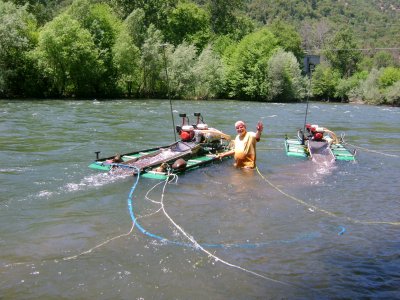
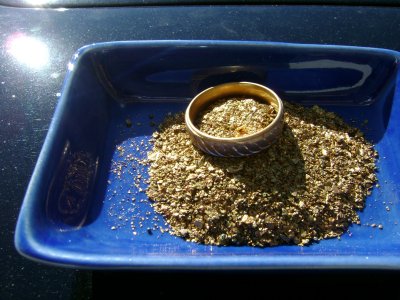
Note: Oregon Now Has Placed a Moratorium on Motorized Prospecting!
With higher and faster water than normal, this dredging season has gotten off to kind of a slow start. I teamed up in mid-June with long-time New 49″er members, Mark Chestnut and Jim Yerby, in a mutually-supportive sampling effort. We could have resumed work in the pay-streak we left behind further upstream late last season. But we wanted to see if we could find something new and better in the stretch of river down near the town of Gold Hill. So we targeted ourselves to be dredging in a high-grade pay-streak by the first of July, allowing ourselves only two weeks to make it happen.
We devoted a lot of time during the first week trying to work out the bugs on a new hot water concept. By “hot water,’ I mean having the means to produce warm water and pump it down into a wet-suit to remain comfortable when dredging in cold water. While it has since warmed up a few degrees, the Rogue River was running at a frigid 51 degrees in mid-June. For maximum flexibility to my arms and shoulders, I prefer to dredge in a 3-mil (thin) wet-suit. At least for me, this requires a steady injection of warm water when dredging in the Rogue. Otherwise, my sample dives are likely to be cut short because of being COLD!
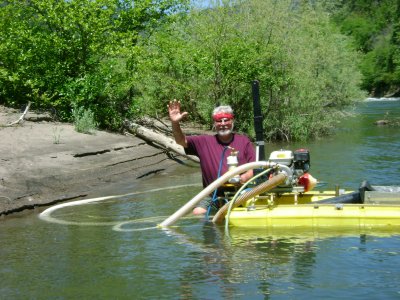 While I already have a good heat-exchange system to produce warm water from the exhaust systems on my dredge motors, Mark and I wanted to try and work out a low-cost propane-heated system that anyone could put together with just a little effort. We started with a popular, portable propane camp shower ($120 on ebay). Initial tests in the shop were very encouraging. The small unit looked like it would easily produce enough warm water to keep two dredgers warm! So Mark took the time to fabricate a nice bracket that would secure the shower and propane tank on my 5-inch dredge.
While I already have a good heat-exchange system to produce warm water from the exhaust systems on my dredge motors, Mark and I wanted to try and work out a low-cost propane-heated system that anyone could put together with just a little effort. We started with a popular, portable propane camp shower ($120 on ebay). Initial tests in the shop were very encouraging. The small unit looked like it would easily produce enough warm water to keep two dredgers warm! So Mark took the time to fabricate a nice bracket that would secure the shower and propane tank on my 5-inch dredge.
But we encountered problems with the propane unit once we started sampling in the river. The darn thing kept shutting off on me shortly after beginning each sample attempt! The type of unit we acquired has numerous safety shut-offs built into it. Best we could tell, the unit shuts off if the temperature of the water gets too hot or the pressure of the water pressure varies too much; and there is even a 20-minute timer built in that shut off the heat just after I started each sample! This all had me cutting sample dives short because I was getting cold. That is not helpful when trying to find high-grade!
As we evolved into the program, Mark eventually was devoting 100% of his attention up at the dredge trying to keep the water heater going while I was taking samples; sometimes with that not even working. After about a week of this, we quit the propane idea and reinstalled my heat exchangers. While this worked for me, it did nothing to help Mark on his own 5-incher. Too bad, but we tried!
Helpful hint for those of you who will visit the Rogue River: The water is always pretty cold over there (like in the 50″s). If you are going to dredge, I suggest you want to use something more than a 3-mil wet-suit.
For anyone who desires to move this propane heater concept forward, please see if you can find a portable water heater that does not have all the safety mechanisms built into it. I am told they are available, but have not seen one, yet. I would appreciate a heads-up if you find something that is not always shutting itself off.
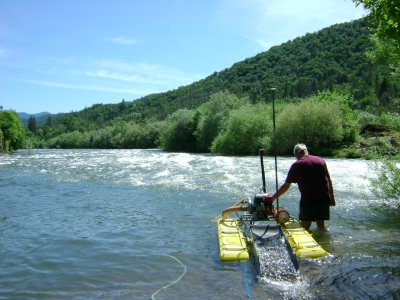 We did our first samples using a 4-incher because the water was so fast!
We did our first samples using a 4-incher because the water was so fast!
There has been more water coming down the Rogue early this season than normal. The higher, faster water has made it more challenging for us to sample well out into the river. This is not only for Mark and me. We have been hearing the same thing from other New 49″er members that have been dredging early this season. While this situation will improve in the coming weeks, Mark, Jim and I have been giving it our best, but still have had to bypass areas along the river we should have sampled in order for us to establish the gold path and figure out where the high-grade is. We will have to return to those places at a later time.
I don”t know why it is; but more often than not, the very best gold is just out of reach. It is like the universe is putting us to the test to see if we deserve to find the really good stuff. I usually only gain access to rich deposits when I make the extra effort to get out where it is more difficult. This sometimes requires extreme effort! It takes a lot of discipline to exert extreme effort when you are not sure that what you are looking for is even going to be there. Your head has to be in the right place. But this is the way I find high-grade gold! High-grade comes easier to some others.
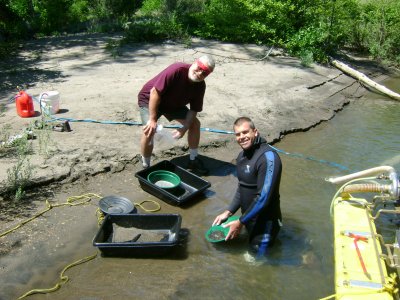 Towards the end of June, Mark, Jim and I found ourselves along a stretch of fast, deep water about a mile below Gold Hill without very much gold to show for the effort we had invested so far. Our two-week target was nearly up, and all of us were beginning to feel like we were just spinning our wheels. You know that feeling? It”s like doing a heck of a lot of work for almost nothing!
Towards the end of June, Mark, Jim and I found ourselves along a stretch of fast, deep water about a mile below Gold Hill without very much gold to show for the effort we had invested so far. Our two-week target was nearly up, and all of us were beginning to feel like we were just spinning our wheels. You know that feeling? It”s like doing a heck of a lot of work for almost nothing!
I had seen several dredgers in this particular stretch of river last season. And even though they said they were not doing very well, all their body language gave me the feeling like they were doing pretty well. The problem was that they were dredging way out in the middle of the river, a place which was going to be difficult to reach with the water still flowing high and fast. Nobody was dredging down there yet this season. Conditions were still too difficult.
I took the first dive on this particular sample, with Mark and Jim topside attempting to prevent the dredge from submarining while I was dredging the deep, fast center-part of the river. “Submarining’ is when the front of the dredge dips underwater, and then gets forced down by the current, ultimately ending up with the dredge upside down in the water. I have been there and done that. It is not fun!
Submarining is a real concern when you are dredging in deeper water, because the weight of streambed material in a longer stretch of suction hose that is not sitting on the bottom of the river will sometimes pull the front of the dredge underwater. Fast, deep, water is even worse, because the strong current usually completely suspends the entire suction hose (placing all the weight of the suction hose on the front of the dredge), and the strong drag against the hose can cause nearly any dredge to take a dive. This was nothing new to our team, since we had already been sampling deep, fast water for two weeks.
A big rain storm upstream had caused the river to run turbid on this particular day. I only had about two feet of visibility on the surface. Doing the best I could, I crawled out into the river on a shallow shelf of some ancient cemented gravel. We have found that there is a lot of this “false bedrock’ along the Rogue River.
The fast current swept the suction hose back as I was crawling out into the river with the suction nozzle in hand. I didn”t have any good traction on that slick surface, so I got dragged out with the hose, and was thinking, “Here I go again!’
Extreme conditions require extreme solutions: This is not something I would advise others to do. But sometimes in dredging situations like this, the only way I have found to get out into the middle of the river is just allow the current to sweep me out there with the suction hose and hope that I will get dragged across something along the river-bottom that I can get a hold of. Then I start a sample hole from there. I do this by crawling straight up in front of the dredge to the end of my suction hose, in this case 25-feet upstream, with a firm grip on the suction nozzle.
Jim Yerby and Mark were managing the dredge on topside with ropes on this particular dive. Their objective was to allow the dredge to get pulled out as far towards the middle of the river as possible, without allowing it to do a full submarine dive. Then I made a full charge towards the middle of the river along the bottom as the current on the suction hose swept me around in a 25-foot ark.
Using this method, once I get out as far as I believe the circumstances will allow, I start trying to capture a hand-hold along the bottom without surrendering the suction hose to the current. Sometimes, I cannot make it happen and end up down below the dredge at the end of the suction hose. Sometimes I do not make it on the first try, but I see a starting point that I can try for on another attempt.
I know this method may seem risky to some people. And it is. There is risk anytime you do something in the water. For some, it is more risky than for others. The more extreme the conditions are, the less margin there is for error or surprises. I almost drowned on a project in Cambodia several years ago when I was using this very same method and my airline got caught around the base of some boulders, trapping me out in the fast water with my air supply kinked off. That was a close one!
The thing is, we could have just waited two or three weeks to sample this section of the Rogue, and most of the serious risk to Mark and I would have been reduced with the slower, summer flows. But we didn”t want to wait; we wanted to get into some high-grade!
When I swept around into the fast water in this place, I was immediately surprised to discover that the shelf ended and the river dropped straight down about 12 feet to the bottom of the river. While in freefall from the shelf, with the poor visibility, I had no idea how deep it was going to go. It was pretty scary. This, by the way, is one of the reasons we tie our suction hose off to the dredge with rope. Worst case, if all else fails, I can always try and shimmy up the 25-foot suction hose to safety.
The sudden drop into deep water shook me up a bit. But with 90 pounds of lead strapped to my waste, all I could do is go with it and hope my ears would clear with the increased pressure. Fortunately they did. Visibility was only about a foot in the deeper water. So I landed on the bottom before I even saw it.
It took a few seconds for me to reset my internal foundations (get over the trauma and fear). My air supply was still working alright and warm water was flowing into my suit. This meant that I had not sunk the dredge when I dropped over the edge with a death-grip on the suction nozzle. That was good! Mark told me after the dive that he had to put his full body weight on the backside of the dredge to keep it from submarining when I got dragged off the shelf with the suction hose.
It is good to have good support when you attempt difficult operations like this! Here is an introduction to Mark Chestnut. We have been dredging together off and on since 1987, and even had a great adventure together in Borneo:
While the fast water was pulling really hard on my suction hose, I was able to maintain a fixed position on the bottom of the river and get a sample hole started. This is always the most challenging part, because you have almost nothing to help you hold a position on the bottom of the river. Once you get a hole going about the size of a wash tub, things get quite a bit easier. I don”t really mean “easier.’ I mean less difficult. Sometimes, holding the suction hose against fast waster can require so much effort that my arms go numb. But if I let go of the suction hose, chances are that I will never be able to get the hose back into the sample hole unless I start all over again with the hose up in front of the dredge and make another jump for it. It is easier to just tough-it-out and capture the sample on the first try!
This sort of extreme sampling is something we do in a first effort to find high-grade in fast water or on a wide section of river. Then, once we find the gold deposit that we are looking for, we try and rig up something different so that we can work the deposit with less physical effort all at once.
Along the bottom of the river, I found hard-pack which was so compacted that I first thought it was the cemented gravel. But it wasn”t. The material came apart with some effort. The hard-pack here was only about two feet deep, sitting right on top of the cemented gravel. Cemented gravel in this area would require more than a suction dredge to pull apart. Water visibility on this day was too poor for me to slow down and look for gold. So I invested all my effort into sucking a sizable amount of material through the dredge.
My arms were exhausted after about an hour of holding the suction hose against the strong current. I had sucked enough material to get a good idea of how much gold was present. So I let the suction hose go and surveyed the steep cliff towards the side of the river to try and find a route back to the surface. There wasn”t one! You cannot just swim up there wearing 90 ponds of lead, and you cannot jump that far. If I tried jumping for it, the strong current would sweep me to the end of my airline even before I touched down on bottom, again! That would not be good.
This drop-off from the shallow shelf on the side of the river was like a vertical underwater cliff. Poor visibility prevented me from seeing how far it was to the top. There was no way that I could find to get up the cliff except to try and pull myself hand-over-hand by holding onto rocks protruding from the cemented gravel which provided poor, slippery hand-holds. The current swept me off the wall twice and I ended up down at the end of my airline, a place I do not like to be. This is the same as being at the very end of a rope over a bottomless pit. I just barely made it to the surface on the third try. This was a dangerous place to dredge!
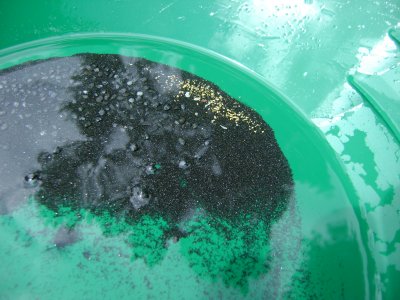 Here was the gold from a handful of material from the upper-end of the sluice; definitely a good sign!
Here was the gold from a handful of material from the upper-end of the sluice; definitely a good sign!
We were totally surprised to see how much gold was in the clean-up! Nearly all of the gold was in the form of tiny flakes. The bottom of the river here was packed with fine gold! We still needed to do another sample to confirm the deposit was more than a small starburst. I have turned up good initial sample results a number of times, only to find out afterwards that there was no workable high-grade deposit present. But a second positive sample in near proximity is usually something to get excited about. Still, Mark, Jim and I were feeling pretty good about this. It was the best sample we turned up in two weeks of effort. Our level of enthusiasm had been turned up a notch or two.
The water in the river had cleared up quite a bit by the following day. We moved the dredge forward some distance and repeated the same exercise with me getting dragged off the shelf by the strong current into the depths of the Rogue River. It was all easier the second time, because I was expecting the steep drop ” and I could also see better on the bottom with four or five feet of visibility. Still, it was everything I could do to get the sample done while holding 25-feet of 5-inch suction hose suspended against that strong current. The results from the second sample were about the same, millions of small flecks of beautiful gold! We found a new pay-streak!
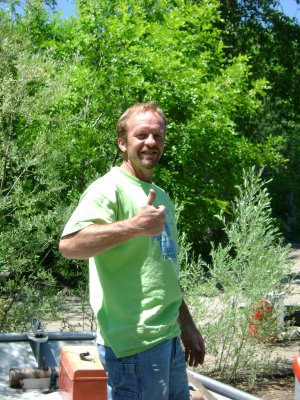 Jim Yerby captured our excitement in the following video sequence shortly after we confirmed the gold deposit:
Jim Yerby captured our excitement in the following video sequence shortly after we confirmed the gold deposit:
From earlier experience, we already knew the Rogue River is loaded with fine gold. So I had retrofitted this 5-inch dredge with a special double-screen classification system this past winter; the purpose which is to direct finer particles of gold into a more-protected, slower-moving recovery system where smaller-sized gold can drop out.
The best way to see how well a new recovery system is working is to dredge a bunch of gold into it. Mark, Jim and I took our time to establish where most of all this fine gold was stopping in my box. Fortunately, most of it was in the top third. And there was almost zero gold in the final portion of the box. Things were looking good!
The big, remaining challenge we faced was how to work this new pay-streak out in the middle of that fast, deep water. When we have faced this problem on our properties along the Klamath River, we usually used boulders along the river bottom to anchor the suction hose to the bottom. But I was not seeing any boulders along the bottom of the Rogue in this area to use as anchors. We had to come up with some other way to reduce the pull of the suction hose out there in the middle of the river.
Our initial idea was to couple an additional 15 feet of suction hose onto our existing hose, increasing the entire length to 40 feet. The idea was to anchor the coupler out in the river with a long pendulum line (“swing line’) that we could angle out from a tie-off upstream on the side of the river. This worked pretty well on the next sample which I dredged, but still did not help me get out into the river as far as I wanted to go. So then we strapped a 60-pound weight belt to the coupler to hold it to the bottom of the river. The combination of the swing line and weight belt out on the coupler now enables us to anchor the coupler pretty-much as far out into the river as we want to go. This allows us 15-feet of working suction hose on the bottom of the river that is relatively unaffected by the (very) fast water. My guess is that this will evolve into a standard way to rig our dredges so we can work out in the middle of this or any other wide river. Here follows Mark”s visual demonstration of this new rigging method:
Important note: You have to be extra careful when working with any ropes in moving water to make sure there are no loose ends or unattached lengths of rope that you or your airline can get caught up in. When working in deep and/or fast water like this, you should also rig your airline so that it does not end up wrapped around anything or become caught up in any way that will prevent you from reaching the surface in an emergency. And you should never attempt doing things that you are not comfortable with. Safety is a personal matter. You are the one who is most qualified to know what your limits are. These stories I tell about the things that I personally do are not meant to be an encouragement for you to reach beyond your own capabilities.
Along with a magic golden ring that we found, our first clean-up weighed in at 1.9 ounces. This was a good start, so we paused to congratulate each other that we had met our initial target of establishing a new high-grade pay-streak within the first two weeks of the season, even if it was on the 14th day.
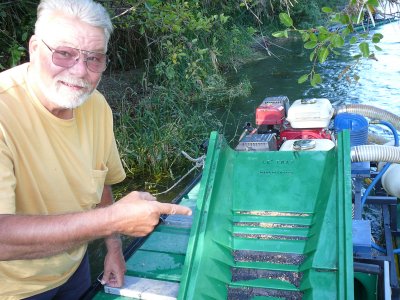 Jim pointing to Mark’s first clean-up. Not bad!
Jim pointing to Mark’s first clean-up. Not bad!
A day later, we rigged Mark”s 5-incher with the same coupler concept and a swing line supporting an additional 15-feet of suction hose. We launched Mark out into the middle of the river about 80 feet downstream of my dredge. He was into good gold on the first day and has been improving his daily production ever since!
Looks like it is going to be a good season!
While the rumors of bank-to-bank New 49″members dredging up the Rogue River are not true, we do have quite a few members present there. Some others have also been struggling with the early season high water (fast). I have talked with several members who are doing pretty well. I am sure more will be onto the gold as summer flows slow down a bit and allow people to get further out into the river. Here follows a video sequence showing some of the other active dredging programs along this very scenic river:
We Have Good Suction Dredge Opportunities in Oregon!
We struck high-grade gold while dredging along the Rogue River during both of the last two seasons and are back into high-grade again this season. I am personally spending time on the Rogue River providing encouragement to members who wish to operate your dredges during this season.
We have a Map and an Access Guide for all members who wish to suction dredge along the Rogue River in southern Oregon. Members are invited to contact our office for more information.
Waiting to See What California will do about an Extended Moratorium on Suction Dredging!
Thanks to all of your hard work, Governor Brown has been persuaded to veto that part of the ongoing anti-mining budget language that eliminated the last bit of funding to finish the ongoing (and nearly completed) review of the Environmental Impact Report (EIR) that supports our regulations. We should all pause for just a moment and allow ourselves a pat on the back for making that happen.
However, additional language in the existing budget bill imposes a continued moratorium on suction dredging in California until new regulations are developed which “fully mitigate all identified significant environmental impacts’ and, “A fee structure is in place that will fully cover all costs to the department related to the administration of the program.’
The problem is that DFG has identified significant impacts in the EIR which do not fall under DFG jurisdiction to mitigate (like water quality and archeological factors). Furthermore, existing California law does not require DFG to “fully mitigate’ environmental impacts; as long as the impacts are identified and balanced appropriately to other factors, such as the need to keep from imposing unreasonable burdens upon small business and private property.
On top of this, it is the legislature which would need to enact a law to change our permit fee structure. This is not something DFG has the authority to do! Since the legislature can take up our permit fee structure anytime they like, it is totally unreasonable for them to pass a law preventing DFG from issuing permits until the legislature gets around to addressing our fees. Crazy!
Here is just one more example of how anti-mining special interests are influencing our lawmakers in Sacramento to pass laws which overrule existing Administrative Law that is supposed to create a level playing field and foundation to encourage and protect capital investment into California. When will this nonsense end?
That the governor vetoed the language which prevented our EIR from being completed inspires some degree of hope. I will be doubly-surprised and encouraged if the remaining anti-mining language also goes away. All we can do now is hope the governor is listening to the thousands of messages which have been directed to him.
However, if the remaining moratorium language is passed into law, we will need to mount a court challenge against the State of California for passing a law which overrides and contradicts existing Administrative Law that is supposed to apply equally to the development or review of all environmental regulations in California.
On that note, I want to sincerely thank all of you who responded to my call for financial support (for our legal fund) in the June newsletter. While we still have a way to go, initial response has been encouraging enough for us to launch another fund-raiser (below).
Drawing Winners for 3 Ounces of Gold!
We did a drawing on three ounces of beautiful gold at our weekly potluck in Happy Camp on 2 July, 2011. This was for gold which I personally dredged from the Rogue River during the 2010 Season. Here is how it all turned out:
Grand prize of one ounce: David Glenn
Quarter-ounce winners: Michael Wong, Eric Hansen, Hugh White & Gerard Buggey
One-pennyweight winners: Sean Hart, Rolf Groff, Graig Sherlund, Ronald Watson, William Christasen, Raymond O’Hagan, Gerard Buggey, Jan Nelson, Nancy Stanford, Kelly Bisel, Timothy Eppich, Les Martin, Keith McRobert, Joe Martin, Ernest Logsdon, Donald Flickinger, Brian Thorne, Michael Campnell, Robert Heitmanek & Randol Thrasher
Any contributions which were received past 12 noon on 2 July have, and will continue to, generate drawing tickets for our new fund-raiser, which will be for three more ounces of gold. This time, the prizes are in the form of gorgeous American Gold Eagles. The girls in our office will automatically generate a ticket in your name for every $10 legal contribution we receive ($100 would generate 10 tickets, etc). There is no limit to the size or frequency of your contributions, or to the number of prizes you can win. The drawing will take place on 4 November, in plenty of time to get the American Gold Eagles sent out before Christmas!
We greatly appreciate help from you in regenerating our legal fund!
Our 2011 Season is off to a Good Start
Because of the existing moratorium on suction dredging in California (until the ongoing Environmental Impact Report is completed), have been focusing mainly on other types of mining along our mining properties in northern California this season. This includes panning, sniping & vack-mining, sluicing & high-banking & electronic prospecting and other types of prospecting that do not use a suction nozzle within an active stream, river or creek.
Our first three weekend group mining projects were well-attended and produced plenty of gold for all participants to get a nice share. There are two more planned during August 6 & 7 and August 27 & 28. These events are free to all active Members, and everyone is invited to attend. Please contact the office in advance to let us know you will be there: 530 493-2012.
Sign up for the Free Internet Version of this Newsletter!
We strongly encourage you to sign up for the free on line version of this newsletter. The Internet version is better, because you can immediately click directly to many of the subjects which we discuss; because the on line version is in full color; and because you can watch the free video segments which we incorporate into our stories.
The New 49’ers Prospecting Association, 27 Davis Road, Happy Camp, California 96039 (530) 493-2012 www.goldgold.coma>





